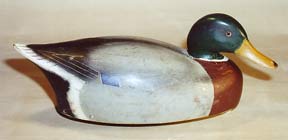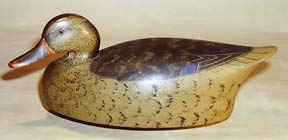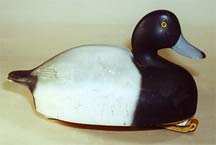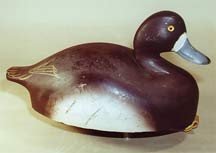by Richard Cowan and Richard LaFountain
 On March 28, 1958, a little more than a year after a fire destroyed the original facility in Old Saybrook, Connecticut, Ted Mulliken sold Wildfowler Decoys to Robert "Rab" Staniford Jr., who moved the operation to Quoque, Long Island, New York. In an open letter to his customers, Mulliken extolled Rab’s qualifications, telling them that Staniford "got his early training making decoys working for Wildfowler." Staniford had indeed worked as "summer help" at the Old Saybrook factory during his college years. Mulliken pledged to "remain semi-active in the new corporation as a consultant and designer." Thus, with a high degree of continuity assured, Wildfowler was soon making decoys in Quogue. On March 28, 1958, a little more than a year after a fire destroyed the original facility in Old Saybrook, Connecticut, Ted Mulliken sold Wildfowler Decoys to Robert "Rab" Staniford Jr., who moved the operation to Quoque, Long Island, New York. In an open letter to his customers, Mulliken extolled Rab’s qualifications, telling them that Staniford "got his early training making decoys working for Wildfowler." Staniford had indeed worked as "summer help" at the Old Saybrook factory during his college years. Mulliken pledged to "remain semi-active in the new corporation as a consultant and designer." Thus, with a high degree of continuity assured, Wildfowler was soon making decoys in Quogue.
 Staniford, an independent insurance broker and a stock salesman for Woodward Walker, was an avid sportsman. He was an excellent shot and for many years was president of the well-known Long Island-Wyandanch Club. Rab was born and raised in Brooklyn, where his father worked for Brooklyn Union Gas. When his father retired, the family moved to Quiogue, a small hamlet west of Quogue. Here Rab befriended local baymen and hunted and fished as much as possible. As an adult he moved to nearby Westhampton Beach, where he lived during his Wildfowler years. Later in life he married his wife, Eleanor, and they lived in Locust Valley, where Rab continued to carve for family and friends. Staniford carved his first decoy in 1937 and continued to carve and paint during a long life until he passed away in 1992. Staniford, an independent insurance broker and a stock salesman for Woodward Walker, was an avid sportsman. He was an excellent shot and for many years was president of the well-known Long Island-Wyandanch Club. Rab was born and raised in Brooklyn, where his father worked for Brooklyn Union Gas. When his father retired, the family moved to Quiogue, a small hamlet west of Quogue. Here Rab befriended local baymen and hunted and fished as much as possible. As an adult he moved to nearby Westhampton Beach, where he lived during his Wildfowler years. Later in life he married his wife, Eleanor, and they lived in Locust Valley, where Rab continued to carve for family and friends. Staniford carved his first decoy in 1937 and continued to carve and paint during a long life until he passed away in 1992.
Les Tooker was a carpenter, decoy maker and part-time guide on Shinnecock Bay. His willingness to give up his carpentry job and go to work at Wildfowler was a key factor in Staniford’s decision to purchase Wildfowler and bring it to Long Island. It is not clear what, if anything, survived the fire in Old Saybrook, but Tooker, as foreman of the Quogue factory, made many new patterns by copying existing Old Saybrook decoys. Chuck Watson of Westhampton Beach, a well-known carver, carved a number of head models in those early days. Tooker’s grandson recalls that Staniford also purchased a second hand "hat block" carving machine from a Canal Street firm in New York City. Several members of the Long Island Decoy Collectors Association have artifacts from Old Saybrook that were purchased at the Quogue factory when it went out of business. Also, a member of the Mulliken family said that many patterns were stored at the Wysowski facility that turned some of Wildfowler’s patterns over the years. It certainly appears that everything was not destroyed in the fire, despite that implication in a 1978 article in North American Decoys.
The Quogue factory produced the traditional styles and sizes of decoys that were developed in Old Saybrook. The Superior model continued to be the most popular. According to the 1958 catalog, the "New Superior models" were slightly wider (7 inches) with a longer base. However when directly compared to Old Saybrook decoys, any changes appear to be insignificant. The advertising statement may reflect the gradual changes made over the years at Old Saybrook.
 Superior models were made almost entirely with high-density balsa bodies and hardwood heads. The catalog also lists tupelo decoys at a savings of 50 cents per bird and hollow pine decoys for an additional $1.25. Few of either of these variations have been discovered, so one must assume that production was small. Normally a dozen birds consisted of eight drakes and four hens and were available at savings of $4.00 over individual prices. A 10% premium was charged for special assortments. A nail-on, crescent-shaped weight was available and these are often found on Quogue birds. Superior models were made almost entirely with high-density balsa bodies and hardwood heads. The catalog also lists tupelo decoys at a savings of 50 cents per bird and hollow pine decoys for an additional $1.25. Few of either of these variations have been discovered, so one must assume that production was small. Normally a dozen birds consisted of eight drakes and four hens and were available at savings of $4.00 over individual prices. A 10% premium was charged for special assortments. A nail-on, crescent-shaped weight was available and these are often found on Quogue birds.
The 1958 Quoque price list and the 1960 catalog show decoys that look identical to those in the Old Saybrook catalogs, with some interesting additions. Among the new listings was a "Chesapeake Model." This was a small (12 inches) decoy with a semi-round bottom; it was offered in canvasback, bluebill and redhead. These were available in tupelo, a wood not listed in the Old Saybrook catalogs, as well as balsa. The Chesapeake model seems to have replaced the "Battery Model Oversize" which is not listed in the Quogue catalogs.
The 1958 price list indicates that Superior and Atlantic Coastal models could also be purchased in tupelo. Among the items recovered when the Quogue factory closed were several lathe-turned diver bodies made of tupelo that were heavy and badly checked. Staniford indicated in a 1961 interview that it was not satisfactory decoy wood. It appears that production was limited, as few finished tupelo decoys have been found. Perhaps he used the seasoned upper part of the trunk and not the green, lower portion from below the waterline. Or maybe he purchased black tupelo instead of the superior water tupelo.
A Moriches Bay gunner returned a dozen broadbills for balsa birds because the tupelo ones absorbed water and slowly submerged while in use. One Long Island collector has several unpainted tupelo canvasbacks and another has some repainted redheads and canvasbacks that also absorbed water badly. However, Chesapeake model divers with the exact same body conformations and made from balsa have been found.
Oversized decoys were available in both the Superior and Atlantic Coast models. The bodies were made of high-density balsa and were from the same pattern used for brant and snow goose decoys. The 1960 catalog also lists silhouette decoys and a gull confidence decoy. The silhouettes were made of Masonite with an oak stake and were available as black ducks, mallards and Canada geese.
The vast majority of the Quogue decoys were made of high-density balsa. The hardwood heads and wooden keels remained standard. The keels varied in size from ¾ by ¾ inch to ¾ by 1 inch. Quite a few unpainted heads were made of maple, suggesting this was the hardwood of choice at Quogue. Some of the oversize and larger decoys, such as the geese, have sugar pine heads. All the heads and body parts were assembled with waterproof hide glue that came in powder form and was mixed at the factory.
It is unclear how many decoy parts – heads, bodies, keels, weights, etc – came from the Connecticut operation, due to the confusing reports after the fire. Hollow pine mallards and broadbills stamped "Quogue" – a special order in the 1958 catalog – have been collected. Cork bluebills with a ¾-inch bottom board were also made. The heads on the cork birds are rather roughly made with overly deep bill carving. Some puddle ducks are found with unpainted glass eyes, but the divers all seem to have strong yellow or red eyes.
Staniford was the president of the company and his sister, Madeline Staniford Hatch, was the secretary-treasurer. Both their signatures occur on a capital stock certificate that was sold for $650 per share in March 1959, a year after Staniford acquired Wildfowler. How much stock was sold and whether this played a role in the eventual sale of the business in unclear.
 The shop seems to have been largely under the direction of Leslie Tooker. Rab was an award winning amateur carver, but Les was the "experienced old man of the shop," according to Walter Roth, a former employee from Center Moriches. Les was a well-known carver and bayman from the Westhampton-Quoque area. He and George Dyhouse ran the machines and did most of the woodwork. In addition to sanders and a bandsaw, there were two 12-spindle carving lathes. An article in the December 4, 1960 New York Daily News shows George operating one of the lathes and Les working at the band saw. Fred Reaver, Tooker’s grandson, relates that the lathes were in their own room separate from the rest of the wood shop. The paint shop was in another building completely. The shop seems to have been largely under the direction of Leslie Tooker. Rab was an award winning amateur carver, but Les was the "experienced old man of the shop," according to Walter Roth, a former employee from Center Moriches. Les was a well-known carver and bayman from the Westhampton-Quoque area. He and George Dyhouse ran the machines and did most of the woodwork. In addition to sanders and a bandsaw, there were two 12-spindle carving lathes. An article in the December 4, 1960 New York Daily News shows George operating one of the lathes and Les working at the band saw. Fred Reaver, Tooker’s grandson, relates that the lathes were in their own room separate from the rest of the wood shop. The paint shop was in another building completely.
Roth, a high school student at the time, was thrilled to work part-time at the factory. Because of his age he couldn’t operate the machines so he worked closely with Al Goldbeck as a painter. The best painter was reputed to be Norman Smith from the Shinnecock Indian Reservation. Roth, a contemporary carver himself, called him an "exceptional painter." Smith, whose wife Natalie’s grandfather was the well-known Chief Cuffee, designed the decorative ruddy duck made at Quogue.
Goldbeck and Smith did most of the painting, with Watson continuing to help part-time, as both a painter and woodworker. Often the birds were painted in assembly line fashion with the first person completing one area or detail who then passed it to the second person for the next element or color. The decoys were held in the painting area by storing them on rolling racks with chicken wire shelves. Spray painting was done for priming, stenciling and the feather detail of the birds receiving the #2 "feather" finish. A 6 by 1-1/4 inch stencil, "WILDFOWLER DECOYS INC. QUOGUE. L.I.N.Y.," is occasionally found.
Roth recalls that latex paint was used at Quogue. Large cans of varied flat colors were opened and powdered talc was added to further flatten the finish. He is unsure about the use of primer, but close examination of finished decoys certainly indicates that a white and/or gray primer was used on the gunning birds.
Staniford arranged with Jayco Paint Products of Ronkonkoma, Long Island to have paints mixed for his color needs. They were latex shake and shingle paints and had the color names written in ink on the cans. One color, "Dune Road/34" was named for a road along the ocean in Westhampton Beach. The cans were stamped on the side, "Special not-returnable." John Kouchinsky, who produced hand made decoys under the name "Great South Bay Decoys" in the 1970s and 80s, was able to purchase the same paint for his use ten years after Wildfowler moved to New Jersey.
Roth said that most of the production when he was there in 1958 and 1959 was gunning birds, which were shipped out regularly in response to mail orders. The decoratives he saw were gunning patterns carved in hardwoods and stained, or standard birds finished in more detail with artist paints. The decoratives were painted in acrylics and an airbrush was used for painting some details.
In general the paint on the Quogue gunning decoys does not seem to have weathered as well as the paint on the Old Saybrook models, but this may be because fewer decoys were made during the short life of the Quogue operation and fewer have survived. The fact that a high percentage of the Quogue decoys were used on Long Island in salt water may also be significant.
Goldbeck was also a skilled carver as well as a skilled painter. . He carved and painted many of the miniature decoys and flying bird miniatures sold in the retail shop. He also made matchboxes with tiny decoys attached and other decorative items. He even made small models of a Barnegat Bay sneak boat and a Moriches Bay grassed punt. Although a pattern for carving miniatures at Quogue has never been found, it’s likely they used a pattern similar to those used at Old Saybrook.
Wildfowler Quogue produced quite a few birds that were not branded. Large numbers of kits were sold to hunters who assembled and painted them. These were not usually branded. Staniford was also accommodating to fellow gunners. He often sold turned, but unfinished, bodies to local hunters who added their own heads and completed the decoys. Friends were frequently found in the shop on weekends making and painting their own decoys.
Staniford was resourceful and recycled materials when he could. He bought old walnut furniture and cut the bases for decoratives from table leaves. Larger pieces, such as table legs, were used for carvings. He also purchased at least one truckload of surplus balsa life rafts. Tooker and his grandson stripped the tarred canvas. The outer wood was cut away and the dense inner wood was utilized for decoy bodies.
Larry Udell, a guide from Center Moriches, took Staniford hunting numerous times. "He was a heck of a nice guy, but he was too generous," he says. "He would give me a gallon of paint if I asked for a pint." One year he gave Larry a dozen and a half puddle duck decoys as a Christmas gift.
Rab was an enthusiastic decoy collector and on many occasions traded new Wildfowlers for old decoys, some of which went into his collection and others were refinished and sold in the shop. He was instrumental in organizing the decoy show held at the Museums at Stony Brook in 1959, and subsequently, in the early 1960s, he donated a portion of his collection to the museum. A fellow member of the Long Island-Wyandanch Club, Newbold Herrrick, gave the museum his rig of Bill Bowman shorebirds, and instantly Long Island’s premier museum collection was born.
 Staniford was quite willing to produce special orders for hunters. Two well-known special orders are noteworthy. A large rig of Michigan style bob-tailed broadbills was made of cedar for Charles Belt, a wealthy Long Island hunter. A second well-known rig was made to replace decoys lost to shifting, salt water ice. The story is related by Staniford’s long time friend, Ron McGrath. Staniford’s gunning partner, Langdon Thorne, had a rig of broadbills carved by Lem Ackerly of Patchoque, who worked for Thorne as captain of his yacht. A sudden wind and tide change swept away much of the rig so Rab made Thorne new ones. Staniford copied the Ackerly decoys and reproduced them in balsa. Balsa "Ackerlys" show up from time to time on Long Island as a result of this enterprise. They have both the Wildfowler and L.K. Thorne stamps, one on either side of the keel. Staniford was quite willing to produce special orders for hunters. Two well-known special orders are noteworthy. A large rig of Michigan style bob-tailed broadbills was made of cedar for Charles Belt, a wealthy Long Island hunter. A second well-known rig was made to replace decoys lost to shifting, salt water ice. The story is related by Staniford’s long time friend, Ron McGrath. Staniford’s gunning partner, Langdon Thorne, had a rig of broadbills carved by Lem Ackerly of Patchoque, who worked for Thorne as captain of his yacht. A sudden wind and tide change swept away much of the rig so Rab made Thorne new ones. Staniford copied the Ackerly decoys and reproduced them in balsa. Balsa "Ackerlys" show up from time to time on Long Island as a result of this enterprise. They have both the Wildfowler and L.K. Thorne stamps, one on either side of the keel.
Wildfowler issued two gift catalogs in 1960; both have blue covers and measure 8 ½ by 5 ½ inches. Printed on card stock, they offer a wide variety of items. A mahogany woodcock with an ebony bill mounted on a walnut base was featured in one catalog. One of these was to be seen on the desk of President Dwight D. Eisenhower. There are thermometers and barometers framed by miniature decoys and guns, as well as walnut duck head paperweights. There’s also an oversized duck head paperweight cast of aluminum. Bookends, coffee cups, decorative tiles, bottle openers and doorstops were also available. Goldbeck’s small model boats were featured. Staniford even advertised a limited supply of old decoys "scraped down to the bare wood and then hand finished." Ducks were $16 and brant were $20. By contrast, a new teal decoy lamp with a burlap shade was $12. Andirons, coat racks, gun racks, bookends and lamps were also shown in the 1960-1961 catalogs. Rab experimented with carved fish, but none were ever put into production. Staniford also made pewter pins of the Wildfowler logo, which he presented to employees and friends.
At some point in the life of the Quogue operation, a retail shop became a significant part of the business. The factory was located on Montauk Highway, in those days the major tourist route to Southhampton, Bridgehampton, Easthampton and Montauk Point. Staniford took advantage of these potential customers and the gift shop became a very important part of the annual sales.
As orders for the fall of 1960 were filled, production focused on the Christmas and winter tourist trade. Then disaster struck. A major snowstorm in early December and several more in January practically eliminated the retail shop trade. At the same time failure of expected deliveries of balsa resulted in the loss of at least one large order from South America. Closed seasons on canvasbacks and redheads severely curtailed orders from the Mississippi flyway.
No one knows if the business was solvent before these events, but suddenly caught with a large inventory and no retail trade, Staniford had a cash flow problem. He laid off his employees and proceeded to liquidate stock. Several people recall going to the shop and seeing large piles of decoys for sale at "Two for five dollars." Many items were sold in response to "make me an offer." Large blocks of pressed cork sold for 50 cents.
Production ceased and soon after, the business passed into the hands of Charles Birdsall of Point Pleasant, New Jersey. Another chapter in the Wildfowler Decoys story had come to an end.
Many thanks to Rodney Hatch, George Kahl, John Kouchinsky, Ron McGrath, Don Michne, Jamie Reason, Fred Reaver, Walter Roth, Larry Udell and members of the Long Island Decoy Collectors Association for sharing their knowledge and artifacts for this story.
For the complete story, please see the March/April 2001 issue of Decoy Magazine.
Read Part One | Read Part Two | Read Part Three | Read Part Four | Read Part Five
Tidbits Main Index

|


